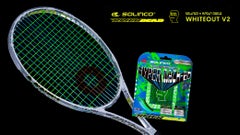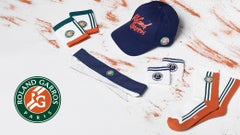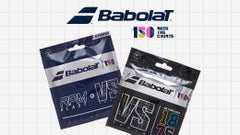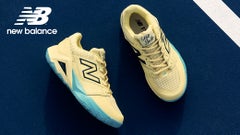Head Liquidmetal 4 Review
You may have heard the bridal saying, "something old, something new, something borrowed, something blue." Well, the Head Liquidmetal 4 fits this saying pretty well. The "old" comes from the concept and manufacturing process of the Liquidmetal 4. All Liquidmetal racquets are made in Austria, with the same high standards which players have come to expect from the company since the original Prestige racquets became world renowned. The "new" comes in the form of Head's latest technology, Liquidmetal. Developed by the California Institute of Technology (Caltech), Liquidmetal alloy has proven to be stronger than Titanium. Head has placed the Liquidmetal alloy in four locations (the silver areas visible on the racquet head) to create what it calls Total Sweetspot Construction (TSC). TSC is designed to increase torsional stability and extend the sweetspot out towards the 2, 4, 8 and 10 o'clock areas of the racquet head. With the inclusion of Head's proven Twin Tube technology, the Liquidmetal 4 borrows a technology which originally found great success in the Head Radical line of racquets back in 1995. As for the blue... well, one look at this racquet will clue you in to that one.
We strung our playtest Liquidmetal 4 with 17 gauge multifilament synthetic gut string at 59lbs. Our playtest was conducted over a three-week period, here's what we learned.
Groundstrokes
From the baseline, the Liquidmetal 4 plays light and maneuverable. Our team found the 102 sq. inch head had a generous sweetspot, and the racquet offered a comfortable feel. First up was Wendi, who said, "I liked the initial feel of the Head Liquidmetal 4 on my groundstrokes. It is much lighter than my normal racquet so I felt charged at the beginning of the set. I was able to generate some great deep forehands with decent topspin. As the set went on, I noticed how much harder I was working to get my normal pace on the ball. I had the best results with this racquet when on the run or when I had to make a quick adjustment."
Noticing the power of the Liquidmetal 4 from the baseline was Josh. "The Liquidmetal 4 plays bigger than its medium power-level rating," said Josh. "I was able to hit deep shots off the forehand and backhand sides without much effort. Anytime I went for a big winner, though, I found the ball sailing toward the back fence. I'm not convinced the Liquidmetal 4 is best suited for players with a one-handed backhand. Even though my groundstrokes had good depth, each backhand lacked the control I'm accustomed to. I was, however, addicted to hitting backhand slices with this racquet. I found myself attacking balls hit high to my backhand and charging the net behind the slice."
Playtester Chris also enjoyed hitting slice backhands with the Liquidmetal 4. He said, "the Liquidmetal 4 offers a good level of comfort when hitting groundstrokes. The feel from the stringbed is very dampened and I never felt any harsh vibration or racquet shock. My favorite shot with the Liquidmetal 4 was the backhand slice. I was able to both punch and float slice shots with good accuracy and control. Hitting an effective slice required very little effort on my part. I had less success when hitting the ball with topspin or when hitting flat. The Liquidmetal 4 was just a little too powerful for me, and I felt like I had to hold back too much when moving the ball around the court. I tended to get even more apprehensive with this racquet on short balls and approach shots. I found the power could really get me in trouble when moving forwards. I think the Liquidmetal 4 would be better suited to a player with a medium fast swingspeed." Groundstrokes Score 71
Volleys
The Liquidmetal 4 performed well at the net for our team. The light weight and maneuverability we noticed at the baseline made for some quick racquet movement on reflex volleys and low pick-ups. Josh found the maneuverability of the Liquidmetal 4 especially useful from the mid-court. He said, "the weight of the racquet allowed for easy maneuverability and the 102 sq. in. head size wasn't cumbersome. Half-volleys were easy to place with this racquet, and I didn't have to generate much power from the mid-court to hit the baseline. I struggled at the net with passing shots that lacked pace, and I was forced to concentrate on punching through the ball more than usual."
Chris fared much better at the net with the Liquidmetal 4 than he had at the baseline. "On the whole, my volleys felt pretty clean with this racquet, even though the dampening doesn't give much of a crisp feeling. The Liquidmetal 4 also played quite light, and this made it easy to maneuver for reaction volleys. I found more control when at the net, and the Liquidmetal 4 seemed to play better the less I swung it. I also had better touch at net compared to baseline play. Short angled volleys came off with a predictable feel and good direction. The maneuverability of the Liquidmetal 4 worked to my advantage when scrambling for low volleys and I was able to make some nice pick-ups."
Wendi said, "I felt this racquet was solid at the net. It had good maneuverability and stability. My volleys could have been a little deeper, as I wasn't getting much pop from the racquet. I found half-volleys were surprisingly easy to control, but on the other hand, I was having some trouble placing touch volleys." Volley Score 73
Serves and Overheads
When serving and hitting overheads our team would have liked a little more mass than the Liquidmetal 4 had to offer. Wendi said, "the Head Liquidmetal 4 didn't do much for my already slow serves. I couldn't get the speed out of it that I wanted. It was light and comfortable, but not hefty enough for me. On overheads it provided great control, but not the pace to ensure a winner."
Josh found good placement when serving with the Liquidmetal 4, saying, "this is a fun racquet to serve with, but watch the weight! Placing the ball in the corners and down the 'T' on first and second serves was easy. I had to restrain myself from hitting too many hard first serves because the racquet was too light. I could feel some fatigue in my shoulder and elbow after only a couple of service games."
"I got some good pop on first and second serves and was able to whip the racquet through the contact zone," said Chris. "Spin was decent, and I found slice a little easier to generate. I found I had to concentrate on really generating lots of spin on second serves to avoid over-hitting. However, the extra power felt pretty good when blasting flat serves down the center 'T'. I picked up a few more cheap points per set serving with the Liquidmetal 4. When hitting overheads, I found the maneuverability of the Liquidmetal 4 to really pay off when hitting lobs that were hit low and with pace. If my opponent didn't get enough height with the lob, it was easy to whip the racquet through quickly and keep the ball out in front. When hitting higher, floating lobs, I would have liked a little more mass from the racquet to keep it stable through contact. I felt like I could have added some weight to the head and handle of the racquet. I would add a touch more to the handle so that I could benefit from some extra mass without losing a lot of maneuverability." Serves & Overheads Score 78
Serve Returns
The power from the Liquid Metal 4's 102 sq. inch stringbed allowed our playtesters to have success with short, compact swings on the return. Josh found hitting deep returns with the Liquidmetal 4 didn't require a whole lot of effort. "Again, the word 'ease' comes to mind with this racquet, said Josh. "I kept everything compact and simply used the existing pace of the serve to hit returns. Unfortunately, I couldn't take my return game to the next level with the Liquidmetal 4. I was never able to truly attack a second serve from either side. The racquet was just too powerful." Chris agreed, saying, "a short compact swing or chip return worked best for me. If I tried to accelerate through the ball and drive it, I found my shots flirting with the baseline with little room for error. I would have liked a little more weight for stability when returning heavy serves, although comfort was very good."
Wendi found the Liquidmetal 4 fit her return game well. "This is where I really liked the Head Liquidmetal 4," said Wendi. "I think its light weight served me well to make quick adjustments for oncoming serves. I used the power from the serve and put it to work for me. I was able to hit aggressive returns as well as block returns on harder serves." Returns Score 74
Overall
'Tweener racquets, such as the Liquidmetal 4, tend to combine characteristics from game improvement racquets and player's racquets - depending on the type of player the racquet is designed for. The Liquidmetal 4 fits more towards the power and game improvement end of the 'tweener spectrum of racquets. The large sweetspot and built-in comfort technology gives the Liquidmetal 4 a slightly dampened feel. Our team members did not notice any harsh vibration or racquet shock during the playtest. In fact, each team member praised the comfort of the racquet at some point during the playtest. The weight and balance of the racquet makes it easy to get around, and we noticed that a player need not take a long swing to generate power. Improving players looking to move up from a powerful, game improvement racquet should give the Liquidmetal 4 a try, as it is a racquet that could serve them well through to the 4.0-4.5 level. Likewise, more advanced players with slower swing speeds will find they can generate plenty of pop with the Liquidmetal 4, although they may want to beef up the weight of the racquet to better manage heavy hitting opponents. Overall, the Liquidmetal 4 is best suited to 3.0-4.5 level players. Overall Score 76
Head Liquidmetal 4 Midplus Combined Scores
(Scores are determined by averaging individual play test scores)
|
|
|||||||||||||||||||||||||||||||||||||||
Playtester Profiles |
|
| Chris | 5.0 baseline player currently using a Yonex MP Tour-1 Midsize. Chris uses a full-western forehand grip, has a fast swing style and hits a one-handed backhand. |
| Josh | 5.0 all court player currently using the Wilson ProStaff Original 85. Josh has a long, loopy swingstyle, hits with a one-handed backhand and a semi-western forehand. |
| Wendi | 3.0 player currently using a Babolat Pure Control Plus. Wendi is a steady but aggressive player who hits with a semi-western forehand grip and a two-handed backhand. |
Review date: Oct, 2003. If you found this review interesting or have further questions or comments please contact us.
All content copyright 2003 Tennis Warehouse.








